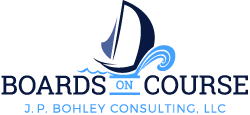Tip #85 Tips for Impactful Efficient Board Meeting Agendas
Tips for impactful efficient board meeting agendas include the following:
1. Be crystal clear about what the job of the governing board is. The Policy Governance® model identifies three core job products for the board: a) ongoing linkage of the board with the organization’s key stakeholders, b) defining board expectations for management and for itself in official board policies, and c) ensuring through intensive monitoring of organizational performance that the board’s expectations for management are being complied with. The board’s expectations for management include expectations about organizational purpose (Ends policies) and operational expectations for prudent and ethical management of the organization (Executive Limitations policies). In the Policy Governance ® model, boards may add other job products to their job description such as financial resource acquisition, a supportive legislative environment, etc.
2. Be crystal clear about how the job of the governing board is different from the job of management. The Policy Governance® model makes a sharp distinction between the roles of the governing board and management. While the board’s role focuses on the job products mentioned above in #1, management’s role is to achieve the board-defined organizational purpose while complying with the board’s expectations for the prudent and ethical management of the organization.
3. Make sure that board meeting agendas focus on issues related to the board’s job and not on operational matters delegated to management (other than ensuring that management is complying with its expectations for the operation of the organization). Strive to avoid drifting into board discussion about matters delegated to management.
4. Specifically, make sure that board meeting agendas include a major focus on defining and re-defining organizational purpose and ensuring that the board-defined organizational purpose is being realized by the organization. In the Policy Governance® model, organizational purpose as defined in Ends policies includes three elements or components: a) what results or benefits are to be produced by the organization, b) which people these results or benefits are to be produced for, and c) ensuring that the results or benefits produced are worth the resources expended to produce them (cost-benefit).
5. In order to be able to define and redefine organizational purpose, boards need to ensure ample board time to process information critical to this board responsibility. Such information includes input received from key community stakeholders (those community members on whose behalf the board governs and to whom it is accountable). Other valuable information includes information from other stakeholders such as employees, customers, and vendors, information about the community and broader societal trends, trends within the organization’s particular industry, changing needs of people that are already or could be impacted by the organization, information from board monitoring of current and past organizational performance, and anticipated/projected future possibilities, etc. Ensure ample board time for such board education and processing of information critical to its role of defining organizational purpose and ensuring the achievement of such purpose currently and into the future. Such an investment of board time is essential to maintaining organizational relevance and sustainability into the future.
6. Make sure that the board clearly defines its operational expectations for management and ensures that these expectations for prudent and ethical management are being complied with.
7. Limit board time that’s not focused on issues related to the board’s job such as chief executive reports on incidental operational matters that have been delegated by the board to the chief executive. A report from the chief executive on operational matters could be sent to board members in advance of the board meeting to limit time spent discussing this report at the board meeting.
8. Place the more important items early on the board meeting agenda.
9. Assign the amount of time to be spent on individual board meeting items. Such assigned times should not be seen as rigid requirements but as a guide for the board chair. A board member can be assigned as time-keeper to assist the chair in efficient use of board meeting time.
10. If an unplanned for issue arises in a board meeting and if it cannot be dealt with quickly, consider deferring discussion of this to a future meeting so that board meeting time remains available for discussion of priority items on the current board meeting agenda.
11. Implement a board meeting evaluation process. One possibility is to allow time at the end of each board meeting to discuss board meeting process and how it might be improved. Another possibility is to have board members complete a brief board meeting evaluation form at the end of each meeting. Completed evaluations can be collected by the board secretary or an assigned board member (or staff member providing board support) who can summarize the evaluation for brief review towards the beginning of the next board meeting. For a sample board meeting evaluation form, please click https://www.BoardsOnCourse.com/resources.
12. Periodically audit board agendas. Assess how board meeting time is actually being spent, and to what extent it is being spent on the most important agenda items.
The Policy Governance® model provides a comprehensive design for efficient impactful board operations. To learn more about the Policy Governance® model, please click https://www.BoardsOnCourse.com/policy-governance.
